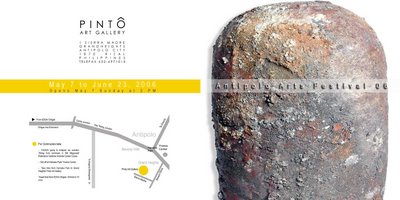 (This show recently opened last May 7. If you wish to visit the gallery, please call us up at 6971015 or email us at pinto_art_gallery@yahoo.com. Thanks!)
(This show recently opened last May 7. If you wish to visit the gallery, please call us up at 6971015 or email us at pinto_art_gallery@yahoo.com. Thanks!)Antipolo Arts Festival 2006 (AAFO6)
Pinto Art Gallery
May 7 - June 23
Curated by Riel Hilario and Jojo Ballo
The Antipolo Arts Festival 06 (AAF06) is a cultural and contemporary art event organized by the Pinto Art Gallery and takes place in the grounds and spaces of the Silangan Gardens in Antipolo City. The AAF06 is a re-organization of what has been an annual tradition of art events organized since 1990 by neurologist and art patron Dr. Joven Cuanang. Its previous name, The Antipolo Maytime Arts Festival, reflected themes of gathering and pilgrimage, the month being a traditional season of homage to the city’s patron Nuestra Senora Dela Paz y Buen Viaje.
The AAF expands the thrust of the event to feature not only exhibitions of art, but also performances, month-long activities of other art fields. It also seeks to open itself to a larger Asian context, with exchanges and exhibitions with artists from the region and elsewhere. AAF also hopes to provide a venue for Asian Art networks through future projects, art talks, residencies and cross-cultural workshops.
Exhibitions:
Gallery 1
Antipolo Young Artists
John Paul Antido, Antonio Ariola, Edrick Daniel, Dennis Fortozo, Guerrero Habulan, Michael Angelo Lampayan, Joven Mansit and Jaypee Samson
Gallery 2
Toushin Maruyama
Ceramics
Gallery Shop
Hadrian Mendoza
Pottery
Monk's Cottage and Gardens
Pablo Capati
Anagama-Fired Stoneware and Sculptures
The House
Anna Varona
Paintings in Oil
Studio Gallery
"Alas-Sais Ym Punto"
Installations by students from
the Philippine High School for the Arts
Bea Alcala, Janea Balquin, Janno Gonzales, Mariel Flores, Andrea Molina, and Jika Regala
Pool Area and Gardens (Opening Day)
Paper Art-to Wear Fashion Exhibition
by Twinkle Feraren in collaboration with:
Wataru Sakuma (Paper/Environmental Technologies)
Otto Retardo (Performance Painting)
Happy Feraren and Ida Del Mundo (Spoken Word)
Madz Abubakar (Sound Installations)
Carmen Reyes (Body Art)
About Pinto Art Gallery
Established in September 2001, Pinto Art Gallery was built by Dr. Joven Cuanang in Silangan Gardens (his Antipolo residence) to serve as a venue for exhibitions of contemporary Philippine art. The structure was designed by artist-in-residence Antonio Leano (one of the founding members of the artist group Salingpusa which broke ground in the Philippine art Scene in the 1990s), who also designed parts of the Gardens and grounds. The Gallery’s thrust is connoted by its name (Pinto or "doorway"), as a threshold and space open of all forms of Philippine contemporary art. The Gallery spaces include not only the exhibitions building but also some structures of the Gardens including the Studio Gallery (which houses the studios of artists-in-residence), the Monk’s Cottage, The Chapel, The Grounds (for open air, installation works or sculptures), and The House. Pinto Art Gallery has three central spaces: Gallery 1, Gallery 2 and the Gallery Shop. Besides exhibitions, Pinto also offers residency for local and foreign artists. Some of its spaces can be rented for small one-day workshops, development seminars and as site for creative projects.



